The period of Renaissance was a unique age marked by liberalism in art and the new vision of the world. The artists depicted human beauty and physical strength. During this period, historical painters might like to think that he represented the supreme achievement of the age, but something still remained to spring up in the shadow of his vast canvases. The movement developed its precise, unrhetorical portrayal of particular fact, and enriched it with the distress and resignation of the poor. Such painters as Donatello, Michelangelo, Albrecht Durer depicted physical beauty of the man as the main ideology of this historical period.
The Renaissance man can be described as a philosopher who tries to understand the world around him through ideals of beauty, philosophical concepts and religion. The Renaissance is considered as the age of the bourgeois, humanist and cultivated–or at any rate paying homage to the ideal of humanism. The greatest moments of his day are those spent in some Renaissance palace, conversing with men like-minded with himself and feasting his eyes on scholars and discoverers, statesmen and condottiere. The church becomes, exteriorly, a magnificent palace; interiorly, a hall where the humanist can meet Christ the Hero in company with the saints. A polite, hierarchical society sets the tone, in which the humanist, enlightened bourgeoisie and nobility can meet and mingle. Its culminating image is that of the absolutist prince, and the background to its spacious living is the Baroque castle, set in its formal landscape. Its great state-room, where the prince receives his people, answers to the interiors of the churches of the period, which often stand with a monastery, built, like the castles, into the landscape (Koestler 294).
For a Renaissance man, a church always succeeds in being religious, i.e. validly itself, when an architect with artistic talent has applied himself to meeting the requirements of the liturgy with the means which his own contemporary style places at his disposal. A truly religious interior has never been the fruit of deliberate historicism; it comes into existence as a genuine statement of reality, as at this present moment, in architectural terms. And it is entirely beside the point for those who stand for a historically conservative style in Christian churches to cite Chinese and Egyptian temples in their support. Readers see Moore as a forward-looking progressive thinker attempting to chart a course into the future that would move beyond the mistakes of the past. Others, on the other hand, see him as a conservative, longing nostalgically for the bygone days of complete Catholic hegemony in Europe and hoping somehow to restore the medieval order. Citizens of Utopia can and do vote in local, state, and national elections outside the community itself, though even there they are expected to vote as a bloc for candidates. In particular, this political activity is part of a plan of gradual expansion that Moore sees as leading in a relatively short time to control the entire communities. The Utopian society goes to great extremes to negate any differences in material circumstances that might lead to rivalries, jealousies, or competition for material gain. For example, the houses of the Utopians are as far as possible all identical. Moreover, to ensure that there can be no question of one family’s house being preferable to another (and that the citizens do not become too attached to their houses), the citizens change houses by lot once every ten years. In short, a principal goal of the Utopian society is to negate differences among individuals. Individual freedom is sacrificed in the interest of universal equality, resulting in a tendency toward conformism that has been a major concern of modern fiction (Koestler 142, 421).
In sum, during the Renaissance, human nature was seen as a part of God’s nature and reflected this ideal. A modern man affirms his freedom through resolute choice and thus attains integrity, or he can abdicate his freedom, neglect to choose, lose his existential centeredness, and succumb to unauthenticity. This factor is as crucial for an understanding of analysis and interpretation of a Renaissance man as is his description of the self as a synthesis of possibility and necessity. The Renaissance paid special attention to the soul and divine power on the Earth. Painting, buildings and sculptures reflected and ideals of renaissance philosophy. Today, the crowd divests the individual of his unique responsibilities and confers upon him at best a numerical significance. It reduces him to a fractional man who is identified with his functions and is thereby replaceable. This does not mean that the crowd possesses some kind of a group substance through which it can act. Action is always the action of individuals within a crowd. Incorporate action each humanist could do what he was unable to do alone. Hence, when one is sacrificed to the crowd, one is sacrificed to the actions executed by the individuals who constitute it. The Renaissance architects worked out plans for such “parochial units”; and sculptors have long since achieved grave stones of worth and dignity. It has always been the privilege of the patron to give his architect and artists directions concerning the requirements of the cult and of local conditions.
Works Cited
Koestler, A. The Sleepwalkers A History of Man’s Changing Vision of the Universe (Arkana). New York: Penguin (Non-Classics), 1990. Print.
Saint, More, Thomas Sir, Utopia. Indianapolis: Hackett Pub. Co., 1999. Print.


